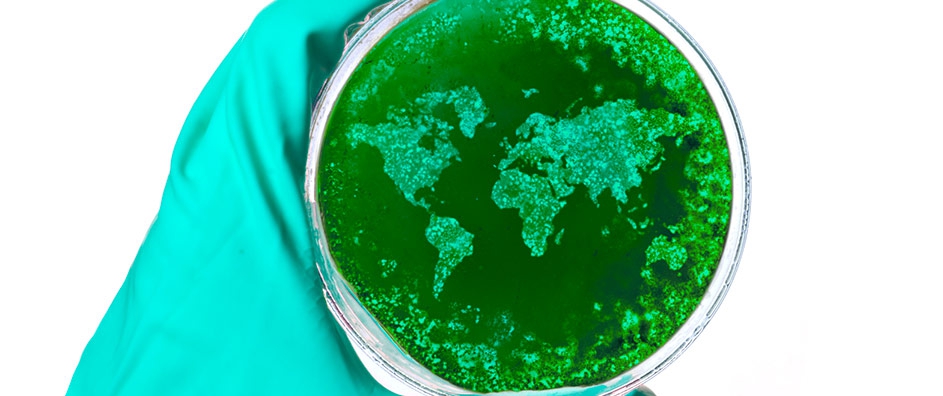The views expressed in our content reflect individual perspectives and do not represent the authoritative views of the Baha'i Faith.
A small disease needs a small remedy, but a disease which pervades the whole body needs a very strong remedy. – Abdu’l-Baha, Abdu’l-Baha in London, p. 59.
In the Northern Hemisphere, winter is coming—which means it’s time for immunization against influenza. Did you get a flu shot yet?
Physician and public health organizations all over the world recommend a flu shot every year. To explain why, I’ll ask another question: Have you ever heard of zoonotic diseases?
If you’ve ever had the flu, you’ve had a zoonotic disease. Zoonotic diseases, as the name suggests, come originally from animals. Scientists have now identified more than 1400 pathogens—viruses, parasites, bacteria and fungi—that can infect humans, and 61% of those pathogens come from animals. It’s likely we first got influenza, researchers have concluded, from animal-to-human transmission, although we still only poorly understand the actual disease vector.
Here’s how the researchers believe it works: the various types of influenza initially come from animal populations—pigs, birds, horses, etc. People who domesticate and raise those animals, or who live in close proximity to them, come in contact with a newly mutated strain of the influenza virus every year. Those people then pass it on to others, and the virus spreads.
Anthropologists have realized that the European colonization of North America and the high death toll among the Indians who already lived there happened largely because of zoonotic diseases. Residents of Old Europe had lived in close contact with domesticated animals for centuries, and had incubated and developed resistance to many zoonotic diseases. By unleashing smallpox, bubonic plague, the measles and many other previously-unknown diseases, white settlers unknowingly—and knowingly, in several early instances of biological warfare—infected the natives, who had few domesticated animals and no resistance to the dozens of deadly diseases that appeared among them all at once. Many researchers now believe that the American Indian death toll during the 18th, 19th and early 20th Centuries came mainly from zoonotic disease rather than war.
Influenza, even in the age of antibiotics, still kills between a quarter million and a half million people every year. Essentially, that’s why we need a new flu shot every fall or winter—because every year the flu virus mutates, changes and adapts in its animal hosts, the better to infect more animals and people. Those little viruses want to live and reproduce, too, you know.
This creates enormous problems for us humans. Animals suffer from the flu, too, but it can cause huge, deadly pandemics in the human population. In 1918, for example, the Spanish influenza virus killed somewhere between twenty and a hundred million people, most of them between the ages of 20 and 40. That terrible pandemic wiped out 5% of the world’s population at the time, more even than the bubonic plague felled in the Middle Ages.
Influenza represents just one of the potentially pandemic zoonotic viruses. A few of the others—HIV, Ebola, Zika, West Nile, Lyme disease, MERS, SARS, etc.—have afflicted the world recently, as they spread beyond their tropical starting points and their original animal carriers. This cross-species transmission of infection has now become known as spillover. Within the past few decades, the world has witnessed more and more spillover of these emerging infectious diseases, and suffered terribly from the results:
As the leading cause of human fatalities worldwide, infectious diseases lead to the deaths of 14 million people per year. Additionally, over three-quarters of emerging infectious diseases (EIDs) are a result of zoonotic pathogens originating from wild or domestic animals and spreading to humans. – EcoHealth Alliance
Few things—war or famine or poverty or prejudice—kill as many people. Within the past century, worldwide deaths from starvation, violence and war have all declined—but deaths from zoonotic pathogens, including previously unknown ones, have risen dramatically.
That should be enough to motivate the world into taking unified action, but this one recently-uncovered scientific fact may raise an even greater alarm: researchers now estimate that in the tropical regions of the world several thousand unique new zoonotic viruses exist among wild animals—and they could soon spill over into the encroaching human population. That estimate of several thousand, by the way, is very conservative—one scientific study concluded that 1.25 million potential new viruses exist among the world’s tropic fauna.
So the obvious question becomes: how do we stop this massive global threat to human health and human civilization? We naturally want to help people recover from such illnesses, especially when our own loved ones contract them, but effective treatments and cures take years or even decades to develop.
Experience has shown that waiting until new pandemics break out doesn’t work well—when we do that, the disease has already spread too far to easily stop. For example—only the heroic efforts of the Africans in Liberia, Guinea and the Ivory Coast, coupled with the massive intervention of the world’s NGO and public health community, succeeded in halting the recent Ebola epidemic, and limiting the toll to ten thousand dead. Even with those efforts, we know Ebola will inevitably emerge again, with a new outbreak creating a new crisis.
We must, the experts say, begin to intervene long before new zoonotic pandemics break out. So in this series of essays, we’ll examine what that kind of pre-outbreak prevention might require. We’ll take an objective look at the state of the world’s preparedness for such potential new pandemics; and we’ll explore the mechanisms that have been proposed to deal with this increasingly deadly global problem. Finally, we’ll consider the spiritual implications of global pandemics—what they mean for the healing professions, for a future state of the world, and for the future state of our souls:
Haste thou to life before death cometh; haste thou to the spring season before autumn draweth in; and before illness striketh, haste thou to healing — that thou mayest become a physician of the spirit who, with the breaths of the Holy Spirit, healeth all manner of sickness in this famed and glorious age. – Abdu’l-Baha, Selections from the Writings of Abdu’l-Baha, pp. 56-57.
Next: How HIV/AIDS Started, and How to Prevent the Next Pandemic
















Comments
Sign in or create an account
Continue with Googleor